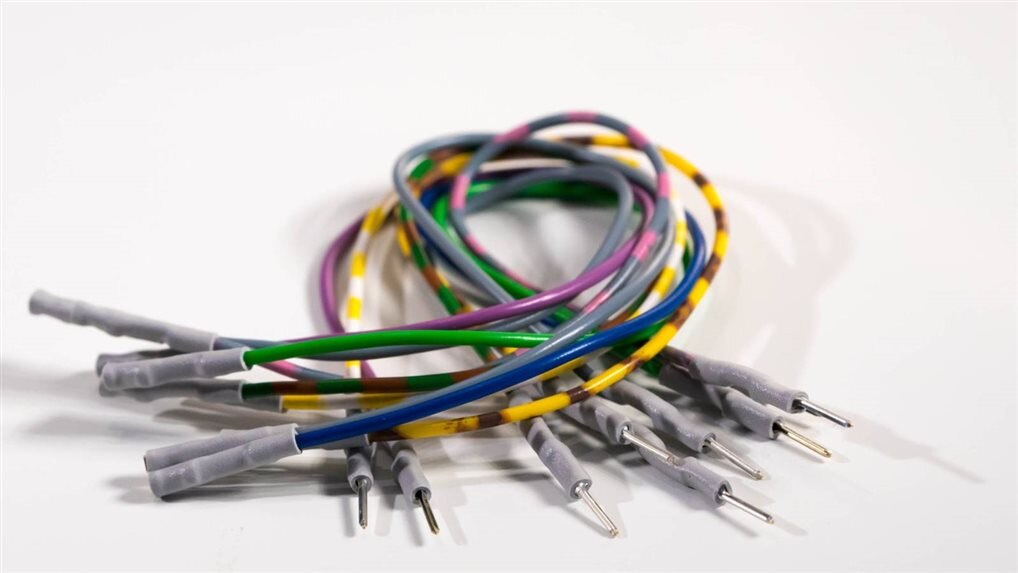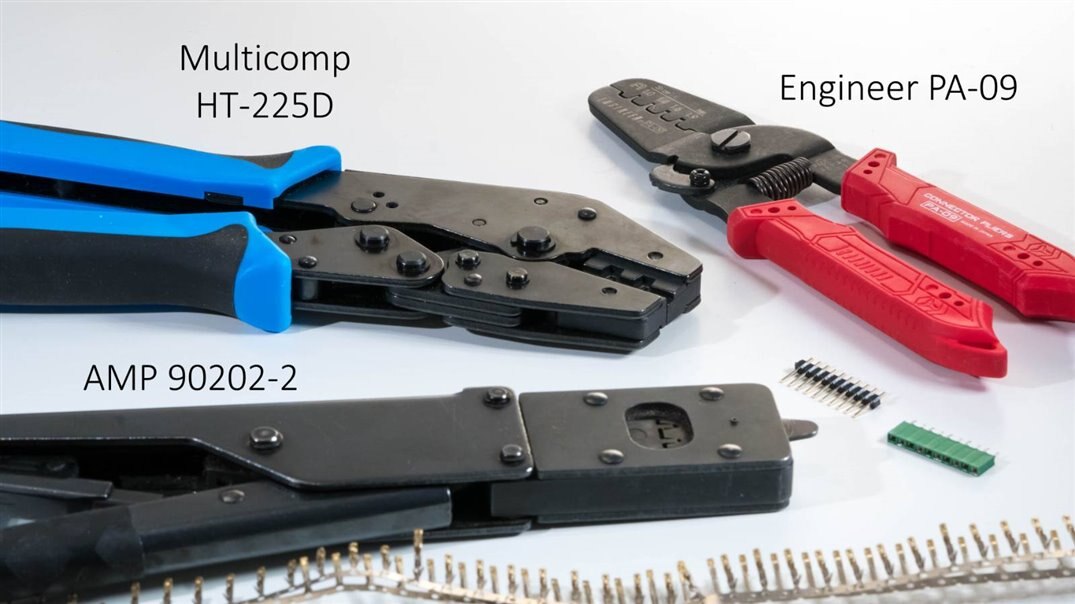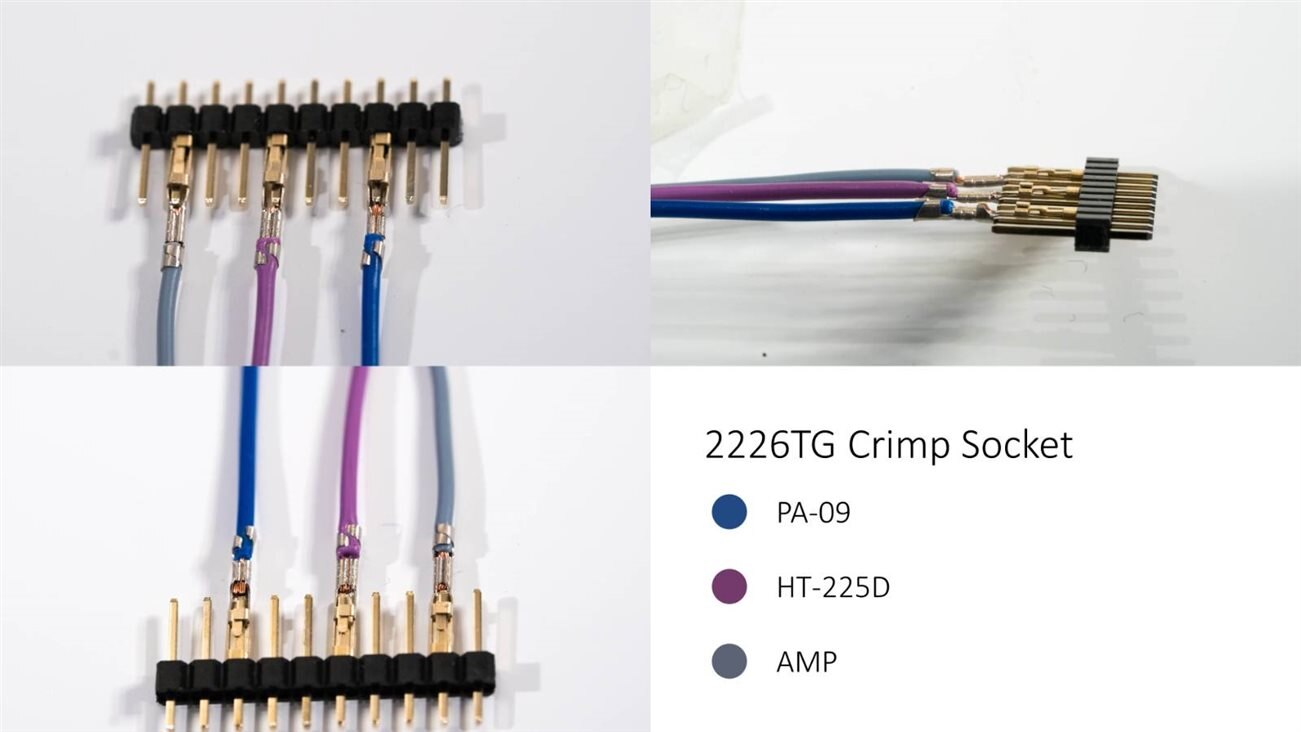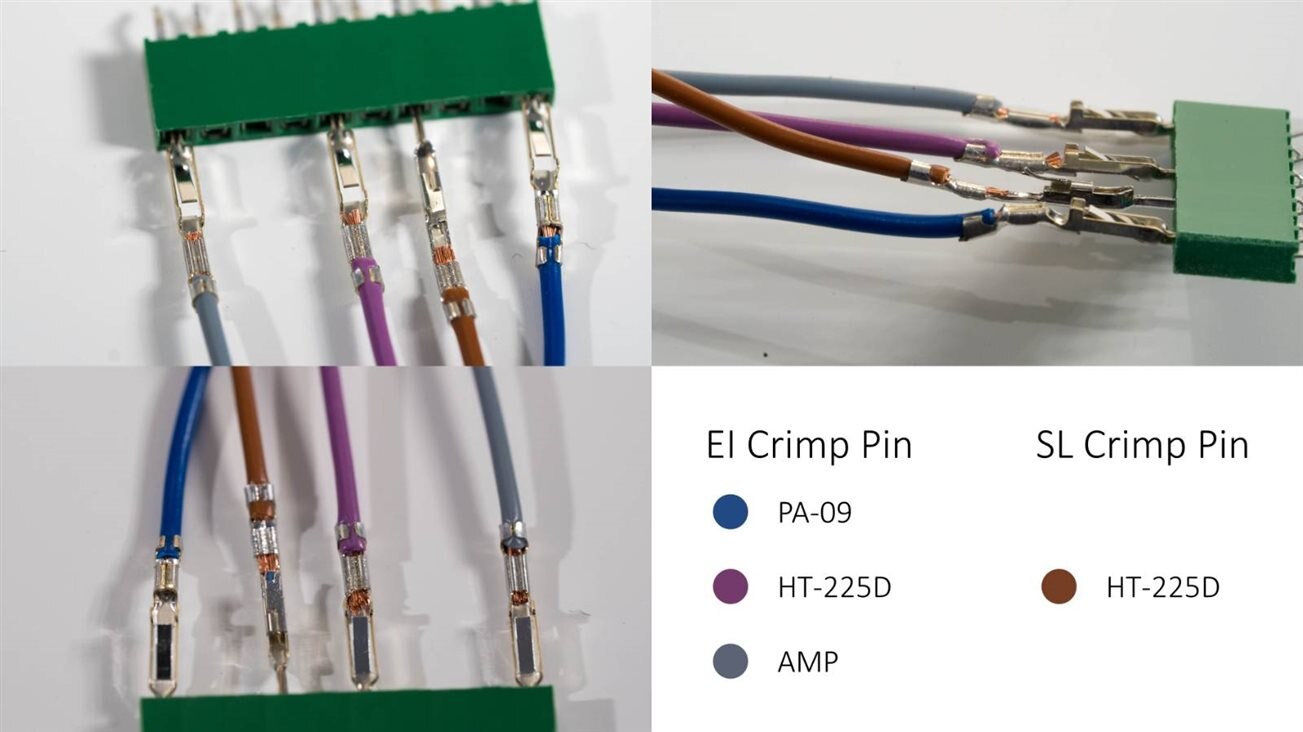Introduction
Making your own jumper cables is quite high on the list of unproductive things to do : ) since they are available ready-made in pinpin, socket socket and pin and socketpin and socket versions. Sometimes I'll just use solid core wire if it is going into board sockets. However, sometimes a custom length or connector is needed on the other end, or even just a different color wire to differentiate signals easily, and then the ready-made cables are less useful.
The photo here shows home-made cables that were made from insulated wire containing 14 strands of bare copper, each 0.14 mm diameter. I stripped a multi-conductor cable to get these wires. I used the same wire in the tests in this blog post.
This blog post is light on the words, it is mostly self-explanatory in video and/or photos.
Here's a 16-minute video:
What Crimp Pins and Sockets?
Pins and sockets are available from eBay, but they are slightly shapeless. I do not think they are worth it, when better gold-plated sockets are available from Farnell at under 3 pence (in quantities of 300 –enough for several years of prototyping!). Pins (tin plated) are slightly cheaper – just over 2 pence in quantities of 100.
Here are some good options:
2226TG Crimp Sockets2226TG Crimp Sockets with gold plated contacts
EI series 170376-1 Crimp PinEI series 170376-1 Crimp Pin with tin plated contacts – 0.70 mm square pin and 18 mm length overall
C-Grid SL series 16-02-0107 Crimp PinC-Grid SL series 16-02-0107 Crimp Pin with tin plated contacts – 0.64 mm square pin and 22 mm length overall
Crimp Tools
Three options that will support the above pins and sockets are:
Multicomp HT-225DMulticomp HT-225D
The AMP tool is a production tool and it is overkill for prototyping. However, it is an old obsolete tool so sometimes available from eBay in used condition (I paid £15 or $20 for mine). It is intended for specific crimps, but it turns out it works with the crimp codes listed above.
Crimp Tools Tested
Engineer PA-09
This tool is suitable for a large range of crimps, in particular JST ranges such as PH (popular with hobby LiPo batteries) as well as JST SH, ZH, XH, RCY, Molex KK, Micro-Fit, C-Grid. There is a chart of supported crimp types.
It is a thin tool and it therefore needs two passes – the first to perform the bare wire crimp and the second to perform the insulation crimp.
There are four possible positions for different sized crimp pins or sockets. There’s no ratchet action, so judgement is needed on how much force to apply when crimping. I judged both wrong in the video (crimp position and the force), and the crimped result detached easier than it should have. For the photos below, I used the correct position (the position marked 1.4 mm on the tool) however the crimp could be pulled apart with pliers (that's an extreme test of course).
A benefit of the tool is that it is easy to examine the wire depth when crimping, because the insulation is visible, and the tool itself can be used as an insulation stop – the video shows this. I think this tool is convenient for the very small crimps, but maybe not the best tool for 0.1" crimps. After doing the test in the video, I subsequently tried the correct position and exerted as much force as I could by hand during the crimp action. I had to prise the crimp away using a screwdriver, because it got stuck in the tool. I then tried pulling the wire using pliers, and the strands again came out of the crimp : ( This did not occur with the ratcheting tools below.
Multicomp HT-225DHT-225D
This tool is suitable for a smaller range of crimps than the PA-09 (the tool has only two positions), in particular 0.1” header crimps pins and sockets, and D-Sub crimps.
A single pass will perform the wire crimp and the insulation grip. That, plus the ratchet action speeds up and simplifies crimping. However, it is harder to set the wire depth. The only One way* I’ve found is to do it visually, by making sure the wire is stripped to the correct length, and then look to see the wire end just begin to egress from the other side of the tool, before crimping down. This works ok, but a physical stop would be better. A speedup method with pin sockets would be to insert one pin into the socket before crimping. The wire would be pushed in until it hit the socket. It relies on the wire being stripped to a precise length though.
The result with the HT-225DHT-225D was very strong - with a pulling force (using pliers) the wire would snap but the crimp would not pull apart.
* Note - I've subsequently found an easier method! See this video:
AMP 90202-2
This tool has a number of nice features. It is intended only for 0.1” crimp pins and sockets (in particular AMP ones!) but it seems to work fine with the ones listed earlier.
Like the HT-225DHT-225D, it is ratchet action and crimps everything in one go. The tool is very light to operate, and has long levers. This is useful when you have have gripped a tool in a suboptimal grip or your hand is busy feeding the wire in – a single hand can be used to crimp with this tool. Or the long lever can be pressed against an arm or table to finish the crimp.
Just as with the HT-225DHT-225D, the result was strong - the wire would snap but the crimp would not come apart.
Crimp Socket Result Photos
The photo here shows the results. Click to enlarge!
Crimp Pin Result Photos
Click to enlarge:
Heat Shrink
To complete the jumper cables, I used 1.5 mm diameter 3:1 heat shrink sleeving1.5 mm diameter 3:1 heat shrink sleeving. A packet will be enough for around 70 jumper cables (with sleeving on both ends).
Summary
The results from all of the three tools are usable, but the AMP and HT-225DHT-225D are faster to use. However, the HT-225DHT-225D requires a bit more attention to ensure the wire is inserted at the correct depth into the pin. This was easier to do with the PA-09, and incredibly easy with the AMP tool. The PA-09 is the most versatile of the three tools since it can crimp a wider selection, but if (like me) you're crimping more 0.1" pins or sockets than the smaller JST crimps, then the HT-225DHT-225D will suit you more. It is easier getting a stronger crimp with the AMP and HT-225DHT-225D tools.
Thanks for reading!






Top Comments
-

fmilburn
-
Cancel
-
Vote Up
+2
Vote Down
-
-
Sign in to reply
-
More
-
Cancel
-

shabaz
in reply to fmilburn
-
Cancel
-
Vote Up
+1
Vote Down
-
-
Sign in to reply
-
More
-
Cancel
-

Jan Cumps
in reply to fmilburn
-
Cancel
-
Vote Up
+5
Vote Down
-
-
Sign in to reply
-
More
-
Cancel
-

fmilburn
in reply to Jan Cumps
-
Cancel
-
Vote Up
+2
Vote Down
-
-
Sign in to reply
-
More
-
Cancel
-

Jan Cumps
in reply to fmilburn
-
Cancel
-
Vote Up
+3
Vote Down
-
-
Sign in to reply
-
More
-
Cancel
-

fmilburn
in reply to Jan Cumps
-
Cancel
-
Vote Up
+2
Vote Down
-
-
Sign in to reply
-
More
-
Cancel
-

shabaz
in reply to fmilburn
-
Cancel
-
Vote Up
+2
Vote Down
-
-
Sign in to reply
-
More
-
Cancel
Comment-

shabaz
in reply to fmilburn
-
Cancel
-
Vote Up
+2
Vote Down
-
-
Sign in to reply
-
More
-
Cancel
Children